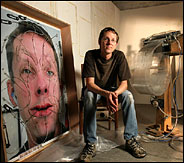 While Christo and Jeanne-Claude were imprinting their own brand of wonders on Central Park, over at the Whitney, California artist Tim Hawkinson had created a big top of his own, an entire floor of trompe l’oeil 2- and 3-D wonders and Rube Goldberg gizmos (here’s a picture of him with “Emoter,” a self-portrait that moves). hawkinson, tim
While Christo and Jeanne-Claude were imprinting their own brand of wonders on Central Park, over at the Whitney, California artist Tim Hawkinson had created a big top of his own, an entire floor of trompe l’oeil 2- and 3-D wonders and Rube Goldberg gizmos (here’s a picture of him with “Emoter,” a self-portrait that moves). hawkinson, tim
By time we got to the Whitney Saturday, we were pretty tired, but Hawkinson pepped us right up. His work has a step-right-up whizz-bang tinkerer quality that comes straight out of garage and kitchen science, model-making, and do-it-yourself with some nails, sticks, string and chewing gum.
 He is one of those artists who measures the world by his own body and who measures his own place by how his body fits in the world. He takes a photo of himself and his hands and then attaches smaller and smaller hands to the tips of his hands until he has built a tree-like network (left, untitled).
He is one of those artists who measures the world by his own body and who measures his own place by how his body fits in the world. He takes a photo of himself and his hands and then attaches smaller and smaller hands to the tips of his hands until he has built a tree-like network (left, untitled).
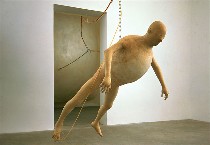 He lies in a tub and photographs what part of himself remains uncovered as every few minutes as black paint fills the tub, thus creating a topographical map of himself for “Bathtub-Generated Contour Lace.” He creates a rubbing of his bones for “Alter.” And he coats himself with latex, and then uses the latex skin like a balloon, vulnerable and somewhat self-mocking (right, “Balloon Self-Portrait”).
He lies in a tub and photographs what part of himself remains uncovered as every few minutes as black paint fills the tub, thus creating a topographical map of himself for “Bathtub-Generated Contour Lace.” He creates a rubbing of his bones for “Alter.” And he coats himself with latex, and then uses the latex skin like a balloon, vulnerable and somewhat self-mocking (right, “Balloon Self-Portrait”).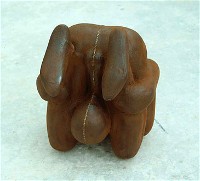 I’m reminded in some ways of Antony Gormley (read post on his talk here in November), whose body casts have become his signature production, a constant self-measuring, a constant exploration of the space within, the space without, and the space within the space (left, Gormley’s “Word Made Fresh,” cast from his own body).gormley, antony
I’m reminded in some ways of Antony Gormley (read post on his talk here in November), whose body casts have become his signature production, a constant self-measuring, a constant exploration of the space within, the space without, and the space within the space (left, Gormley’s “Word Made Fresh,” cast from his own body).gormley, antony
But Gormley’s materials are the traditional materials of sculpture, the cast metal, the static figure. Hawkinson may begin with his body, but then he’s off and running in a thousand different directions, with materials you can find in Home Depot and the Acme. He’s got the disgusting factor and mechanics of Bruce Nauman, but with a lighter touch. Hawkinson’s cares about how things work and whether things are what they seem. He also wants you to see his process.
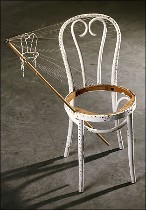 Macrocosms and microcosms enchant him. He takes plugs out of a chair and with them builds a mini-version in “Shrink;” he grinds his fingernails, hair and superglue to construct a 1 1/2″ long egg, “Egg” (right, “Shrink”).
Macrocosms and microcosms enchant him. He takes plugs out of a chair and with them builds a mini-version in “Shrink;” he grinds his fingernails, hair and superglue to construct a 1 1/2″ long egg, “Egg” (right, “Shrink”).
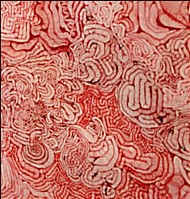 He draws a 420-inch scroll that looks like a map of intestines all in shades of red, calling it the “Wall Chart of World History from Earliest Times to the Present” (detail, left). Then he encases all the red pens and pencils he used into a giant polyester resin finger tip, the red leads poking out looking like a cross section of bloody veins packed into place.
He draws a 420-inch scroll that looks like a map of intestines all in shades of red, calling it the “Wall Chart of World History from Earliest Times to the Present” (detail, left). Then he encases all the red pens and pencils he used into a giant polyester resin finger tip, the red leads poking out looking like a cross section of bloody veins packed into place.
Hawkinson is fascinated by trees. He creates “Rootball,” a tree-root look-alike from cardboard and string. The photo of the hands leading to smaller and smaller ones is a tree, too (second picture from the top).
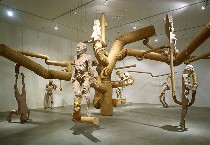 The spectacular “Pentecost” (right) is a treelike structure made of sonotubes, covered with what looks like contact paper with a wood pattern on it. The 12 playful figures, based on the body topography generated in the bathtub piece, are made of stacked slices of polyurethane foam. They look like a cross between humans and apes. Arrayed on the branches, maybe a toe, maybe a finger, maybe a heart or a penis hits the structure, generating a muted plunking sound, the program based on a music-box roller and “found” software, whatever that may mean. I took it as proof of the arbitrariness of the musical score, which was pretty pleasant to listen to.
The spectacular “Pentecost” (right) is a treelike structure made of sonotubes, covered with what looks like contact paper with a wood pattern on it. The 12 playful figures, based on the body topography generated in the bathtub piece, are made of stacked slices of polyurethane foam. They look like a cross between humans and apes. Arrayed on the branches, maybe a toe, maybe a finger, maybe a heart or a penis hits the structure, generating a muted plunking sound, the program based on a music-box roller and “found” software, whatever that may mean. I took it as proof of the arbitrariness of the musical score, which was pretty pleasant to listen to.
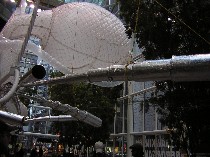 Hawkinson includes music everywhere. Another music box roller, looking pretty much like an African nail fetish, plays a bar or two of “My Favorite Things” in super slo-mo. His “Uberorgan” (left), too large for the Whitney, is installed in the Sculpture Garden at 590 Madison Ave, between 56th and 57th Streets.
Hawkinson includes music everywhere. Another music box roller, looking pretty much like an African nail fetish, plays a bar or two of “My Favorite Things” in super slo-mo. His “Uberorgan” (left), too large for the Whitney, is installed in the Sculpture Garden at 590 Madison Ave, between 56th and 57th Streets.
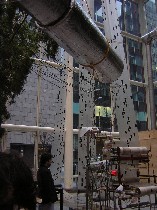 “Uberorgan,” which combines sexy, floating bladders and spectacular horns straight from Gabriel’s mouth, plays music, using an analog of an enormous player-piano roll to program the notes (image right, and for an online video about this, go here). Water dripping on pie pans is the music of his tree of twisted polyethylene, “Drip”–the sequence also roller-controlled and apparently somewhat arbitrary.
“Uberorgan,” which combines sexy, floating bladders and spectacular horns straight from Gabriel’s mouth, plays music, using an analog of an enormous player-piano roll to program the notes (image right, and for an online video about this, go here). Water dripping on pie pans is the music of his tree of twisted polyethylene, “Drip”–the sequence also roller-controlled and apparently somewhat arbitrary.
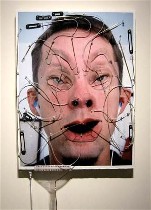 That arbitrariness is part of what makes this work so interesting. Does it rain on Roberta’s street at the same time it’s raining on mine? Not last week, and not in “Drip.” In “Emoter” (right), a self-portrait of the artist is cut up into pieces that move. What determines the sequence is light impulses on a monitor influenced by people in the gallery. A nostril grows. An eyelid droops, a mouth gets larger and smaller. The affect is not that different from the animated Tom Hanks in the “Polar Express.”
That arbitrariness is part of what makes this work so interesting. Does it rain on Roberta’s street at the same time it’s raining on mine? Not last week, and not in “Drip.” In “Emoter” (right), a self-portrait of the artist is cut up into pieces that move. What determines the sequence is light impulses on a monitor influenced by people in the gallery. A nostril grows. An eyelid droops, a mouth gets larger and smaller. The affect is not that different from the animated Tom Hanks in the “Polar Express.”
Part of the fun of this work is seeing how Hawkinson made it. He leaves all the mechanics in view encased in Plexiglas or right out in the open. And they are irresistably crude and charming.
But I think there’s way more going on here, a mind trying to discern his place in the universe as well as trying to make things run. “Pentecost,” as its religious name implies, reaches straight to the ceiling of the gallery, a conduit for talking in tongues and communicating with the divine. The galleries are strung with extension cords from room to room, suggesting that everything is connected and networked and that it all makes sense, if only we had the larger plan.
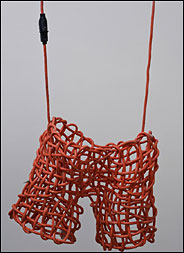 We were looking at Hawkinson with FOAB (Friend of ArtBlog) Knox Cummin, who is no stranger to workshop practices, and who said that the doilies and weavings made to take up the slack in long extension cords is a workshop tradition. He did not claim that “Shorts,” however, were a common approach.
We were looking at Hawkinson with FOAB (Friend of ArtBlog) Knox Cummin, who is no stranger to workshop practices, and who said that the doilies and weavings made to take up the slack in long extension cords is a workshop tradition. He did not claim that “Shorts,” however, were a common approach.
Some of the things Hawkinson made–the elephant skin, made of foil on top of urethane foam, or “Shatter” which was a trompe l’oeil shattered glass made of a web of twisted, bent and woven mirrored plastic film sandwiched by two sheets of plastic, “Armor Ooze” the aluminum foil knight oozing urethane foam –were just fun to look at. If there was a big meaning, I don’t care if I get it or not. I loved looking, I loved the illusion, I loved the tactile confrontation between ordinary materials and fine-art handling.
This is a show to which you could take your kid or your spouse who barely tolerates your interest in art–or you could take your friend who knows more about art than you do. Now that’s an endorsement.









